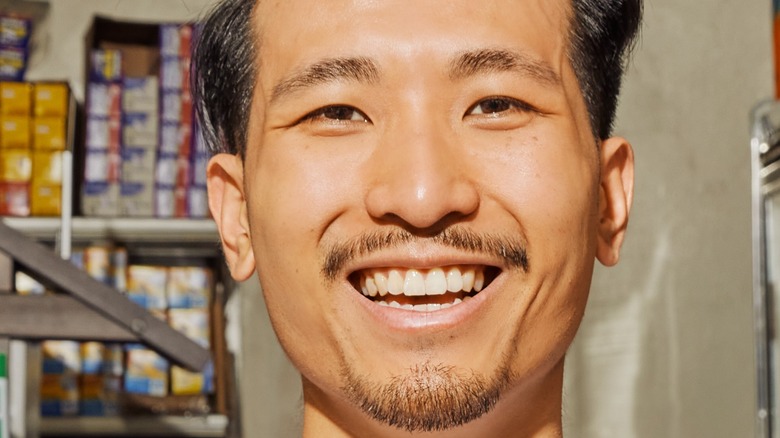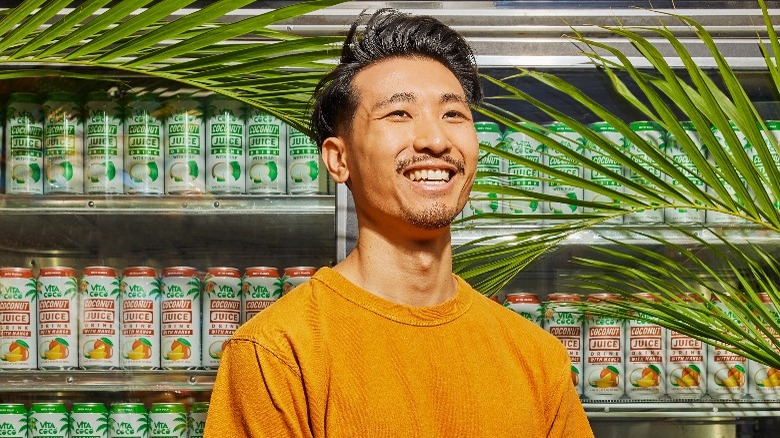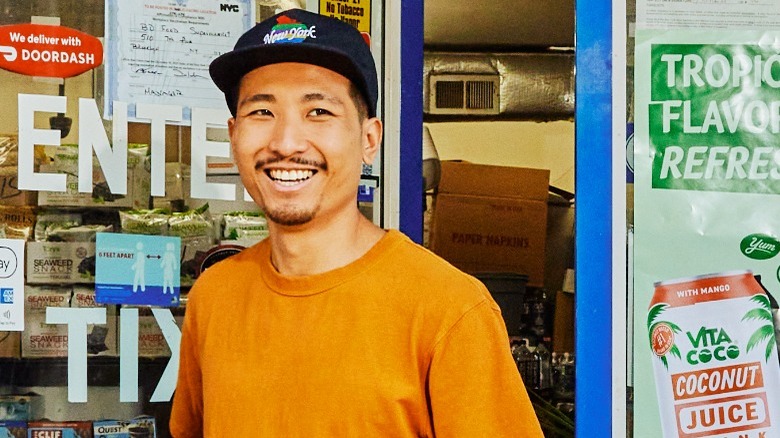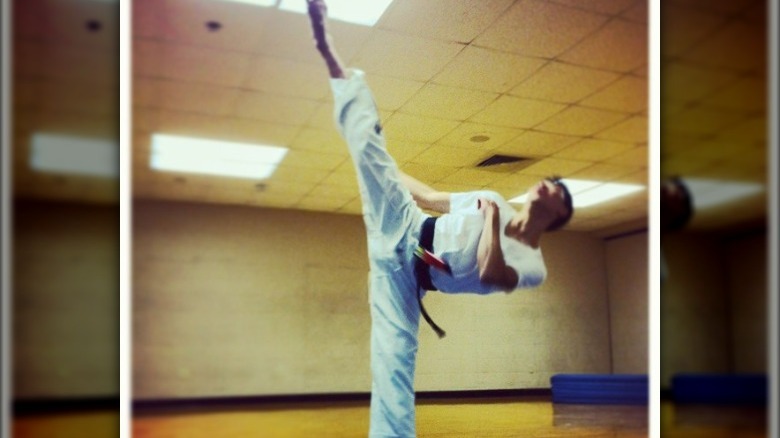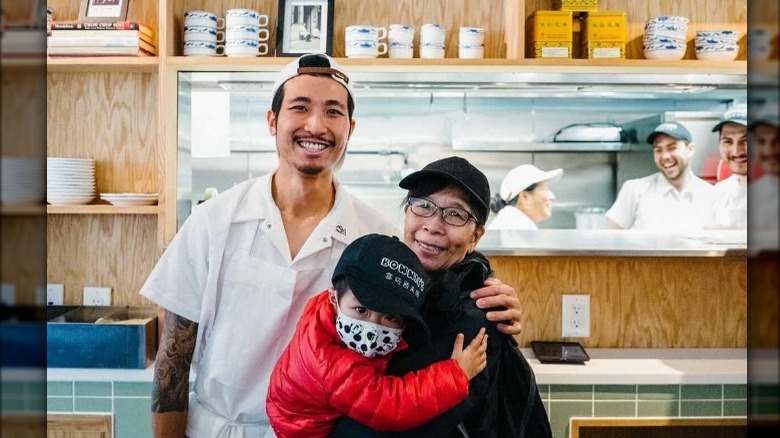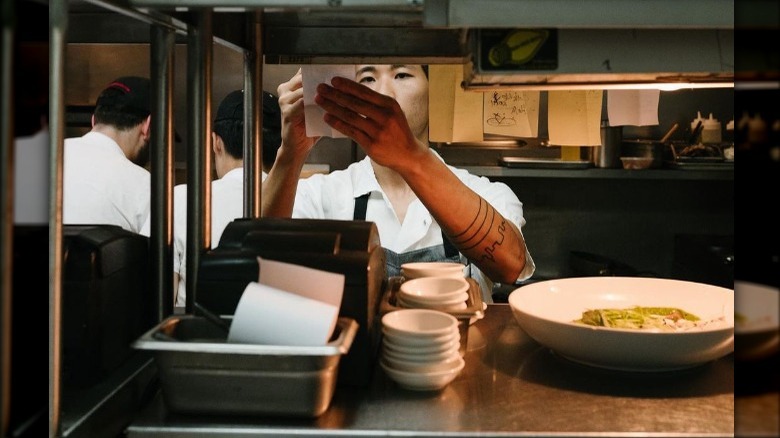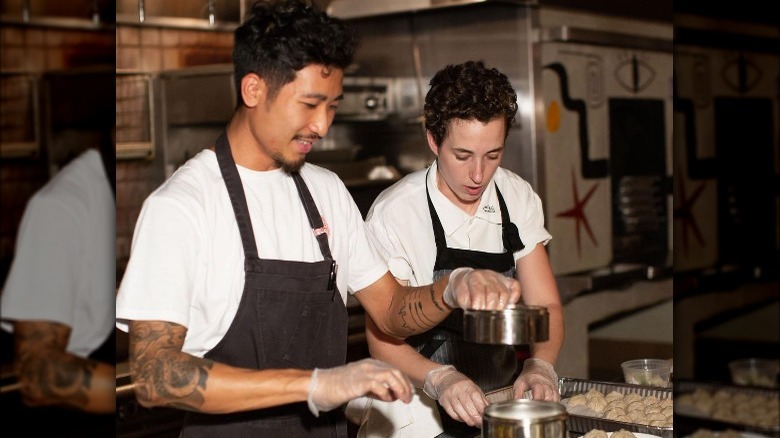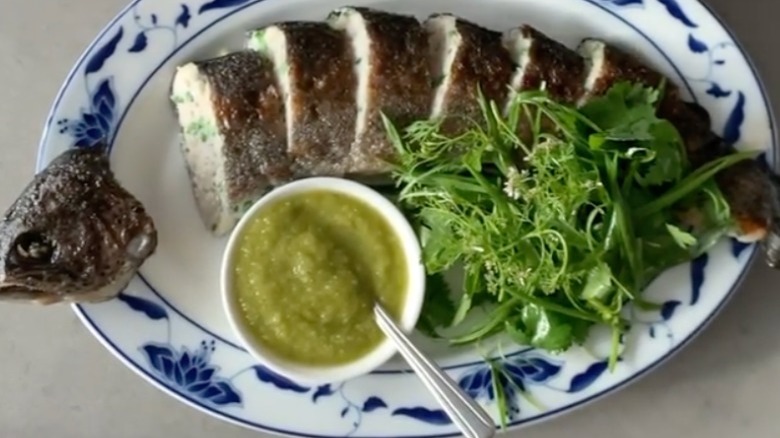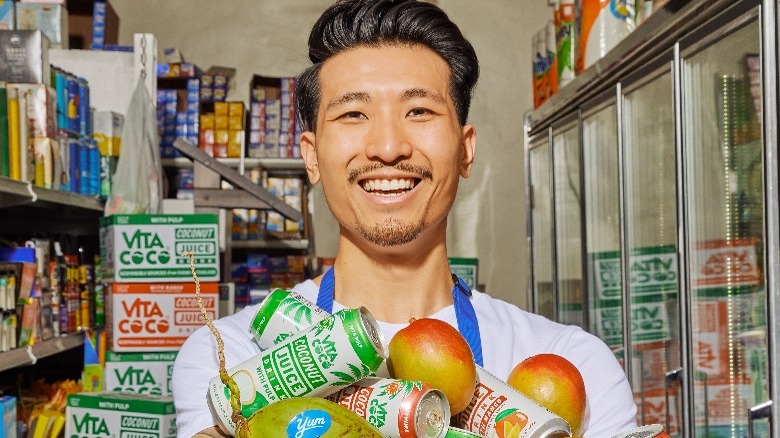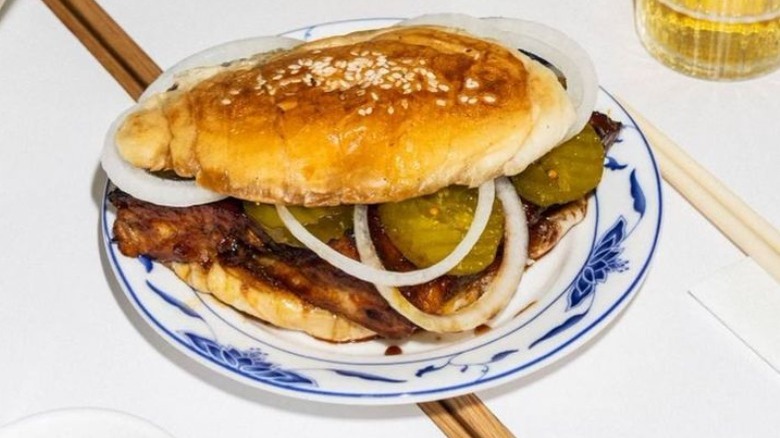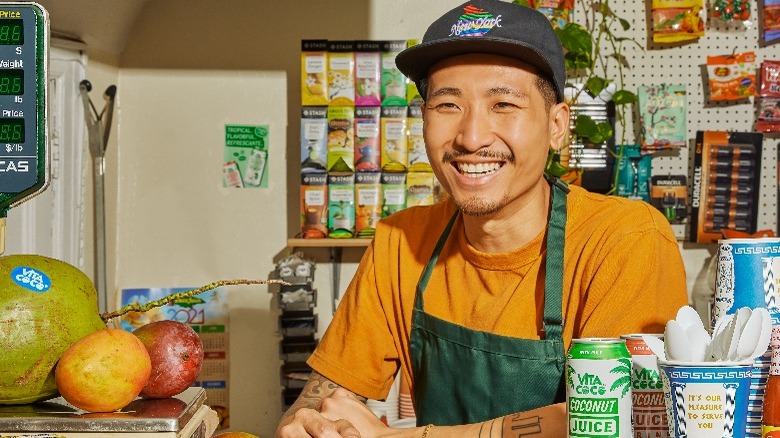Calvin Eng Explores His Roots While Partnering With Vita Coco - Exclusive Interview
Calvin Eng says he doesn't know what he's doing. If that's true, it's true in the best kind of way. For one, he certainly does know how to stuff a fish, perhaps like no one else in the restaurant industry does. Eng would know — he's gone looking for his competition. He also intimately understands food nostalgia. Yes, his restaurant, Bonnie's, is a homage to the food his mom made him as a kid, and it's that food that he still craves the most, but Eng's mastery of food nostalgia goes beyond honoring his roots.
His best selling menu item is a Cantonese-American take on a McDonald's classic, dubbed the cha siu mcrib. "The idea" of fast food does is enough to excite Eng. His McRib might not mimic the flavor profiles of Mickey D's, but it should bring "you back to certain memories and times [of] eating fast food."
When Calvin Eng says he doesn't know what he's doing, he's not belittling his culinary skills — he's talking about opening Bonnie's. "No matter how many times you've done it, you're still figuring it out and [you] have to be willing to figure it out," Eng told Mashed. In Eng's case, "figuring it out" meant earning a James Beard award nomination in the "Emerging Chef" category. In this exclusive interview with Mashed, Eng talks his culinary philosophy, his cha siu mcrib, and his long-term relationship with coconut water, recently formalized through a partnership with Vita Coco, in celebration of its new juice.
Calvin Eng's coconut-inspired menu
As part of your new partnership with Vita Coco, you've created a coconut-inspired menu. Tell us about it.
We basically did our regular menu and collabed with Vita Coco and made every dish and every component have coconut, and that was the goal. We took our main hits and infused either coconut milk or coconut water into every single dish that we did. It was in the sauces, it was in the poaching liquids — we poach chickens in coconut water. We did our shrimp and walnuts, which is usually made with a mayo-based sauce, but we added coconut milk to that. For our fried milk sundae, we basically make milk custard, scoop it up, batter, and deep fry it. We made it with coconut milk instead for the Friday coconut dinner.
How does coconut change the flavors of a recipe for you? What are its powers to transform?
It adds a lot of natural sweetness and nuttiness that makes it super tasty. If you don't like coconut, then you're not going to like it, but if you do, you'll enjoy the little hints that it does add because it does add a lot of flavor.
Talking about another thing that some people love, some people hate, you use a lot of MSG in your recipes. You even sell an MSG martini. Can you give us some of your top tips for using MSG in a home kitchen?
You should definitely use it sparingly and you need to use it with salt. You can't add MSG and expect to get that same effective flavor without having a balance of salt as well. It's really all about the right balance of it all. You need salt, MSG, and sugar usually to have the right balance.
If somebody wants to start experimenting in their home with using MSG who hasn't done it before, do you have a recipe or food that they can start with?
Definitely savory foods. Once you start with that, you can add it to drinks, like you mentioned. I add it to desserts when it's that right balance of savory, umami, and sweet. It's in almost everything — because it's this fine balance. Once you are comfortable using it and understand what it does and what it can do, figuring out the right amount to add to certain things, you'll end up using it like salt once you understand how it tastes and how it affects food.
Calvin Eng gives you permission to use the microwave
You have admitted to using a microwave in your home quite a bit. You use it, for example, for scrambled eggs. When is it okay to use a microwave and when, for you, isn't it okay to use a microwave?
I feel like it's always okay. It's never not okay. Make it taste good.
Is there anything you won't use a microwave for cooking?
I guess anything that's supposed to be crunchy, then no. If it's meant to be crunchy, then I'm not microwaving it. If I'm cooking for anyone else, I probably won't microwave. I'm cooking for myself, I have no problem doing it.
If you could pick anybody to cook you a meal, who would it be?
My mom. I feel like I still crave her food sometimes because as much as I learn and try to copy and replicate it, it's never the same, so that's the one. Growing up, I had it all the time. I took it for granted and now it's the things that I actually crave. I don't have time these days to visit her as much as I would want to, but her food is definitely the stuff I still crave and how she cooks it.
Your restaurant, Bonnie's, you named after your mother. You've talked a lot about what you owed to your mother in terms of your culinary knowhow. What's her favorite menu item on your restaurant?
I feel like everything is so different from what she does and how she cooks, but probably the egg custard. It's not even on the menu right now. We took it off and we'll put it back on when it gets colder, but the congee or the egg custard [are] probably her favorite things. Those are both her ratios and recipes essentially.
Has she given you any tips for improvement?
Yeah. All the time.
Calvin Eng talks martial arts and kitchen culture
You have a black belt in Taekwondo, right?
Almost. I have a second degree, but almost a third degree. I never finished it out.
How do martial arts and the practice of martial arts help you in the kitchen?
I learned all my discipline from martial arts and Taekwondo at an early age. That's where you really push yourself and force yourself to do things in order to achieve certain things, and that really ties together how kitchens and kitchen culture [are].
You say that proper preparation prevents poor performance. It's your mantra and it's in all your training materials. It quickly became really hard to get a reservation at Bonnie's. How do you create an atmosphere in your kitchen that leads to the kind of success you've had, do you think?
Our kitchen is a very ... I always joke that we have the greenest kitchen in New York. It's very young, very green. [For] a lot of [our employees], it's their first restaurant that they've worked at. The way we hire, the way I like to hire, we try to get good people. The job itself is easy as long as you want to do it. We bring in people who are good people and want to learn and want to be a part of this, and we train them to do it, because the work is very easy as long as you're down to do the work. It's a lot of work, it's physical work, but it's not [rocket science]. Anyone can learn to do these things. That's how we build the culture and the environment that we have based on good people first.
Calvin Eng talks what it was really like to open Bonnie's
What's your favorite in the kitchen story since opening Bonnie's?
Oh my God. I feel like every day is a problem in the story ...
Because you've said that nobody really knows what they're doing when they're opening restaurants –
Yeah, that is true still for anything. I got to figure it out. Every time you do something, it's a totally different thing, so no matter how many times you've done it, you're still figuring it out and [you] have to be willing to figure it out. One of the stories is when we tried to open in September, but we ended up opening in December due to so many delays and gas and everything. [It got] to the point where we had a full team of 30 people ready to work at a restaurant, it was ready to go, except that we didn't have gas to cook anything with. We did a no gas popup. I did a whole bunch of popups before we opened the restaurant and then ended up doing a no gas popup in November to bring some money in and to pay the staff something.
We did the no gas popup where it was random dishes that I made. It was hard to make those dishes, because Cantonese people don't even really eat raw or cold things like that. It's always blanched or cooked or something. To come up with a bunch of dishes that had to be cold because we couldn't cook them in anything was extremely difficult. Doing that, doing a no gas popup [was challenging]. [Everything was] brand new — brand new team, brand new restaurant — not knowing the flow, figuring it out. It was extremely successful. We did that for two or three nights ... that was back in November. That's a fun story on how we started, and it made opening easier because we did a version of it with training wheels.
Calvin Eng talks food nostaliga
Your mission with opening Bonnie's has been to educate people on what Cantonese food can be. Has your own perception and your own idea of what Cantonese food can be has changed for you in this journey?
I don't think so. Our mission was to educate our employees and then for them to educate their diners on what it is. A lot of restaurants and chefs end up being pan-Chinese and they don't focus on a specific region, and it's important for us [to do that]. [We aim] to be Cantonese-American, [for] the flavors and ideas to be Cantonese, but influence and our backgrounds and our experiences are the American part. I was born and raised here in America, and the evolution of [the cuisine is important]. I always say it's the evolution of it because food always evolves over time everywhere for every cuisine, through immigration and settling and where people grew up. That's what we're doing here. My idea of it and my philosophy behind it all is still the same and hasn't changed.
Tell us about how the reception to your food has been beyond all of these rave reviews that we're reading online? What's it like talking to people coming into your restaurant and sitting down to eat?
It's cool, because I'm sure you read this somewhere too, and I say it all the time, that nostalgia is my favorite ingredient. I make sure that every dish is nostalgic to me, because [it's the] food I grew up eating and the food that I had at home. It's cool when other people with different backgrounds and different cultures come in and tell me that the food reminds them of this, or reminds [them] of that.
They compare my stuffed fish to Gefilte fish when Jewish people eat it. They compare the tinned dace dip to chicken liver moose, even though there's no chicken in it — but it does have that similar consistency and flavor. For Cantonese-Americans coming in, when they have certain dishes, they're like, "Wow, I haven't had this since my mom made her's..." The whole point of doing it, of opening this restaurant, was to introduce things to people who aren't used to [the cuisine], but to make it still approachable and relatable to all.
The food memories that inspired Bonnie's
Speaking of nostalgia, you credit your time at Nom Wah and the opportunity it gave you to revisit shops, vendors and restaurants for evoking all of these memories. Can you take us back there?
My grandparents lived in Chinatown for 50 to 60 years, and it's the same apartment that my mom grew up in when she immigrated to America from Hong Kong. When we were little, I grew up in Bay Ridge in Brooklyn with my dad's side [of the family], and we would go to my mom's parents every weekend in Chinatown, specifically. I hated it growing up. It was different. I didn't want to be there. I wanted to hang out with my friends.
When I worked at Nom Wah is when I started to revisit a lot of the places I went to as a kid. Seeing how much has changed and seeing how much of it isn't even around anymore [shook me], and it wasn't even that big of a gap. It was maybe a decade of a gap and there was already so much change. That's when I realized that it was also an opportunity and a responsibility to learn more about the food of my heritage and learn more and pursue that.
Before that, I went to culinary school. I cooked, I knew I wanted to open a restaurant, I knew I wanted to cook, but I didn't know what kind of restaurant that was going to be. That was the turning point for me to realize that this is what I should be doing, and [that's when I] probably [started] appreciating [the cuisine] and thinking that it's good and cool.
Calvin Eng's stuffed trout odyssey
Going back to your comment about the stuffed trout that you make [yeung yu sang choi bao]. There's a lot of buzz about that online. Your mom only makes it twice a year because it's so labor-intensive. You've also said that the best food has good backstories. Give us the story of the trout.
I made it with my mom and my aunt when I was younger, literally once or twice a year, because it took so long. I remember doing it in the kitchen. I would be responsible for scraping all the flesh off of all the bones, removing all the bones. It would take hours to do one fish to make it super clean. We would mince that up with shrimp, pork, and seasoning and ... ginger, garlic, [and] chives. We would stuff it back in, and this took all day. Then, by the time we were ready to cook it, it was perfect timing for dinner. We would sear that in a wok till we got it super crispy on all sides and eat this over rice. It was essentially a giant fish cake that was fully boneless, and it was fully intact in the shape of a fish.
That's why when we were opening, doing R&D for the restaurant, I was contemplating doing this fish or steamed fish. At home, growing up for dinner, we always had a fish, whether it was steamed, it was fried, or stuffed. It didn't matter — it was always some type of fish on the table. I knew I had to have something with fish on the menu, and to be honest, my favorite way to eat fish is steamed fish, but it's very easy to do steamed fish. A lot of places do steamed fish, and it was important to showcase a different type [of fish]. The stuffed [version] was a cooler different one that a lot of people aren't familiar with. I was hunting for it for the last couple years, trying to find a restaurant or a place that made it and sold it to try someone else's version to see how they did it, and I wasn't able to find it.
Calvin Eng's favorite ingredients
How did you figure it out how to master the fish?
I watched as many videos as I could on YouTube, and there's not that many out there on that dish either, to learn how other people did it. [What I did find] wasn't far off from what we're doing. There's really no easy way to do it. You get faster [by making the dish], so we ended up doing that, putting it out on the menu ... It's not something that we sell out of any time. If you come in at 5 p.m., you get it. If you come in at 10 p.m., you get it.
That was important, to not have a limited amount of any dish. We want everyone to have the same experience, no matter what time or when they're coming. Now we do that and that's the story on that dish. I still haven't eaten another one because I don't know any other restaurant that does it. When people come in, that's one of the dishes that people say they haven't had it since their grandparents made it. Some people tell me, who grew up in Chinatown, that this lady gives to sell it out of her shopping cart in Chinatown. They haven't had it since then.
You often compare Cantonese food to Italian cuisine in that both are about using minimal but the best ingredients. What are your staple ingredients and which ingredients bring you the most joy when you use them?
Furu, which is like fermented bean curd. We use that a lot. It's an acquired taste right out of the jar, but again, once you understand how to use it, you could use it in a lot of different applications. It adds a lot of depth and umami to dishes. That's definitely one. MSG is another, and salted fish is another product. That's how Italians use anchovies and things like that, but the Chinese one is salted and sun-dried. It's a dry-cured fish that needs to be rehydrated and steamed in order to use it. It's a very strong, pungent smell and flavor, so a little bit goes a super long way.
Is there one ingredient in particular that you couldn't live without?
Salt, but that's not a huge one.
Calvin Eng loves fast food
You have another really popular dish, which is the McRib. McDonald's was a big thing for you, and you've said that you're a fan of an upscale version of TGI Friday's Chicken Piccata. Talk to us about the culinary relationship you have with fast food.
I love fast food. It's delicious. It's smart. I grew up eating fast food, whether it was McDonald's, KFC, Taco Bell, or Burger King. I ate it all after school, every day, pretty much. That's the nostalgic thing for me is the idea of it — not necessarily the flavors, but bringing you back to certain memories and times eating fast food.
It's fun and makes things more approachable for a lot of people. [Many] in America grew up eating that as a kid and still do, and the McRib was a random dish that came on and that is the number one seller. It has been the number one seller since we opened, which is crazy. The idea came randomly one night because I knew I needed to have a sandwich on the menu, but I didn't want to do a chicken sandwich. I felt [there were] a lot of really good chicken sandwiches already.
I didn't want to do a fish sandwich because I knew I was going to have this whole fish, and I was trying to stay away from pork because I knew a lot of people don't eat pork for dietary restrictions and things like that, but pork is very popular in Cantonese cuisine. It made sense to do it, and I wasn't really trying to focus on Char Siu either, like most Cantonese roast meats because there's so many good roast meat shops. This dish came about one day when I was R&Ding steamed ribs, like a dim sum dish. [I tried] utilizing that technique and then ended up making a Char Siu glaze and marinade for it all, and then that evolved into a sandwich.
What's your personal favorite fast food order?
Taco Bell. Crunchwrap Supreme and Doritos Locos tacos.
Why? You didn't even hesitate!
That's the flavor, the texture, the speed, the consistency, the price. It's literally the number one restaurant in New York or the world.
Calvin Eng drinks coconut water at least once aday
Tell us about your partnership with Vita Coco and why it's important to you.
Do you know the whole story and how it came full circle?
Tell us!
My first food-related job was at our family friend's deli when I was 14 or 15. His family — his father and his uncle — would run the shop during the day, and then we would go take over at night after school every day. I would work the grill. He would work the register ... but for someone who had zero professional food and restaurant experience, that was a really good place to start, even though it was just making sandwiches on the grill or making cold sandwiches. It was interacting with guests, interacting with the customers, interacting with each other. We drank Vita Coco almost every day because that was the main coconut brand at the time when we were working there, and we were kids so we didn't have enough money to buy this on the regular, and on our own.
We [could] drink and eat whatever we want there, so we drank so much coconut water because we thought it was good for you. I'm sure it is good for you — we actually enjoyed it. That's where the start of it was. Then, [when Vita Coco] reached out to do this partnership, I thought it was so fitting and perfect because to be able to launch the new product in the space where I started my food career and also where I started to actually drink it made total sense. It's also where they started selling to bodegas and delis when they launched 20 whatever years ago.
You just took a swig of coconut water. Explain your love for it.
Wow, I didn't realize. It's so natural at this point. I love coconut water. I probably drink coconut water at least once a day.
Why?
It's hydrating, it's good for you, and I've heard this myth in the past where you could survive on coconut water. It's got to be good for you because you can survive on it, and I actually enjoy the taste a lot.
Celebrate the launch of The Vita Coco Juice like Calvin Eng! This is the brand's first juice offering, conveniently canned for a quick on-the-go boost with tropical flavors that will transport your taste buds to the tropics, Coconut Juice is available in two flavors – Original with Pulp and Mango – at your favorite 7-Eleven store across the East Coast and Southeast.
This interview has been edited for clarity.
